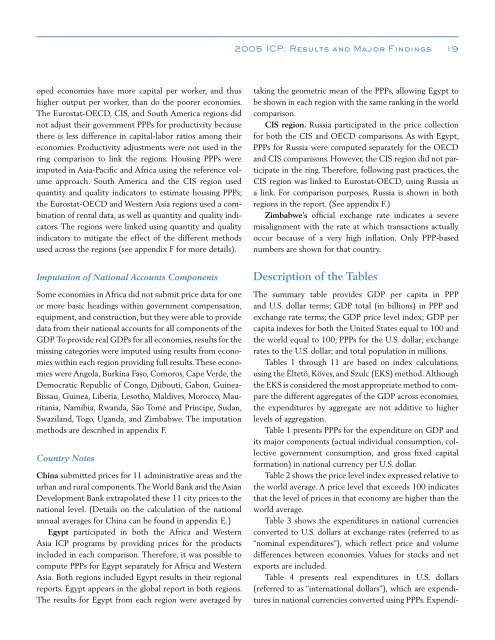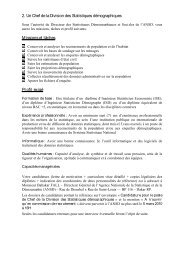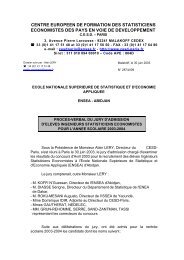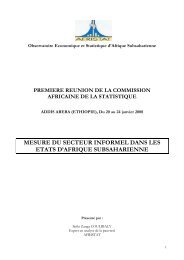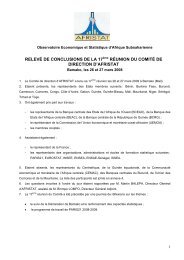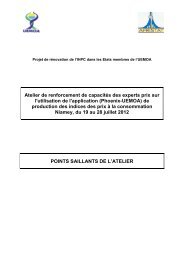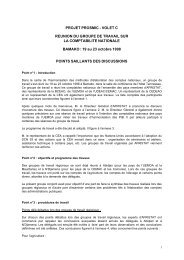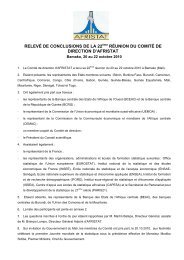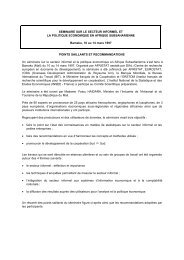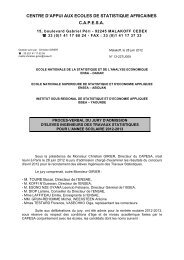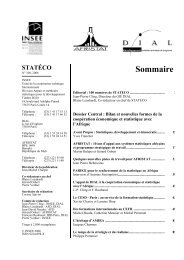Global Purchasing Power Parities and Real Expenditures - Afristat
Global Purchasing Power Parities and Real Expenditures - Afristat
Global Purchasing Power Parities and Real Expenditures - Afristat
You also want an ePaper? Increase the reach of your titles
YUMPU automatically turns print PDFs into web optimized ePapers that Google loves.
2005 ICP: Results <strong>and</strong> Major Findings 19oped economies have more capital per worker, <strong>and</strong> thushigher output per worker, than do the poorer economies.The Eurostat-OECD, CIS, <strong>and</strong> South America regions didnot adjust their government PPPs for productivity becausethere is less difference in capital-labor ratios among theireconomies. Productivity adjustments were not used in thering comparison to link the regions. Housing PPPs wereimputed in Asia-Pacific <strong>and</strong> Africa using the reference volumeapproach. South America <strong>and</strong> the CIS region usedquantity <strong>and</strong> quality indicators to estimate housing PPPs;the Eurostat-OECD <strong>and</strong> Western Asia regions used a combinationof rental data, as well as quantity <strong>and</strong> quality indicators.The regions were linked using quantity <strong>and</strong> qualityindicators to mitigate the effect of the different methodsused across the regions (see appendix F for more details).taking the geometric mean of the PPPs, allowing Egypt tobe shown in each region with the same ranking in the worldcomparison.CIS region. Russia participated in the price collectionfor both the CIS <strong>and</strong> OECD comparisons. As with Egypt,PPPs for Russia were computed separately for the OECD<strong>and</strong> CIS comparisons. However, the CIS region did not participatein the ring. Therefore, following past practices, theCIS region was linked to Eurostat-OECD, using Russia asa link. For comparison purposes, Russia is shown in bothregions in the report. (See appendix F.)Zimbabwe’s official exchange rate indicates a severemisalignment with the rate at which transactions actuallyoccur because of a very high inflation. Only PPP-basednumbers are shown for that country.Imputation of National Accounts ComponentsSome economies in Africa did not submit price data for oneor more basic headings within government compensation,equipment, <strong>and</strong> construction, but they were able to providedata from their national accounts for all components of theGDP. To provide real GDPs for all economies, results for themissing categories were imputed using results from economieswithin each region providing full results. These economieswere Angola, Burkina Faso, Comoros, Cape Verde, theDemocratic Republic of Congo, Djibouti, Gabon, Guinea-Bissau, Guinea, Liberia, Lesotho, Maldives, Morocco, Mauritania,Namibia, Rw<strong>and</strong>a, São Tomé <strong>and</strong> Principe, Sudan,Swazil<strong>and</strong>, Togo, Ug<strong>and</strong>a, <strong>and</strong> Zimbabwe. The imputationmethods are described in appendix F.Country NotesChina submitted prices for 11 administrative areas <strong>and</strong> theurban <strong>and</strong> rural components. The World Bank <strong>and</strong> the AsianDevelopment Bank extrapolated these 11 city prices to thenational level. (Details on the calculation of the nationalannual averages for China can be found in appendix E.)Egypt participated in both the Africa <strong>and</strong> WesternAsia ICP programs by providing prices for the productsincluded in each comparison. Therefore, it was possible tocompute PPPs for Egypt separately for Africa <strong>and</strong> WesternAsia. Both regions included Egypt results in their regionalreports. Egypt appears in the global report in both regions.The results for Egypt from each region were averaged byDescription of the TablesThe summary table provides GDP per capita in PPP<strong>and</strong> U.S. dollar terms; GDP total (in billions) in PPP <strong>and</strong>exchange rate terms; the GDP price level index; GDP percapita indexes for both the United States equal to 100 <strong>and</strong>the world equal to 100; PPPs for the U.S. dollar; exchangerates to the U.S. dollar; <strong>and</strong> total population in millions.Tables 1 through 11 are based on index calculations,using the Èltetö, Köves, <strong>and</strong> Szulc (EKS) method. Althoughthe EKS is considered the most appropriate method to comparethe different aggregates of the GDP across economies,the expenditures by aggregate are not additive to higherlevels of aggregation.Table 1 presents PPPs for the expenditure on GDP <strong>and</strong>its major components (actual individual consumption, collectivegovernment consumption, <strong>and</strong> gross fixed capitalformation) in national currency per U.S. dollar.Table 2 shows the price level index expressed relative tothe world average. A price level that exceeds 100 indicatesthat the level of prices in that economy are higher than theworld average.Table 3 shows the expenditures in national currenciesconverted to U.S. dollars at exchange rates (referred to as“nominal expenditures”), which reflect price <strong>and</strong> volumedifferences between economies. Values for stocks <strong>and</strong> netexports are included.Table 4 presents real expenditures in U.S. dollars(referred to as “international dollars”), which are expendituresin national currencies converted using PPPs. Expendi-


